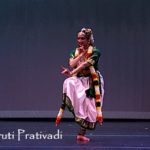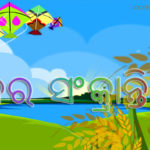The following Post was composed by P.N. Namboodiri ji. You can follow him on twitter.
TiruNrittam — When the Gods Dance in Our Midst
Every year, sometime in March, I make a pilgrimage to my ancestral village to attend the annual festival of the village temple. I am not alone in such a pilgrimage. There are many others, people who are displaced from their ancestral roots like me, who do the same. Elders say that this is important for migrants to undertake, to maintain their links with their cultural roots. It can be said that temples are an integral part of Bharatiya culture and they are the bedrock of its evolution and maintenance.
Kerala can be considered to be a collection of villages, as villages are present across the length and breadth of the state. All these villages are dotted with temples and many villages have more than one temple. This blog is a fond reflection of my thoughts after my recent visit to my ancestral village for this year’s Utsavam (festival) and the impact of such events on the religious, cultural, and family bonds of the life in a typical Kerala village. I have also included brief information on Nrittam, a unique temple ritual in this part of Kerala for the benefit of readers. The description of festival and Nrittam is with respect to our family village diety Chuzhali Bhagavati or Goddess Durga located in village Chuzhali of Kannur District of Kerala.
Temple Worship
“अग्निर्देवो द्विजादीनां मुनीनां हृदि दैवतम् ।
प्रतिमा स्वल्पबुद्धीनां सर्वत्र समदर्शिनाम् ॥
God is Agni for the Brahmins,
In the heart for the Sages,
Idol for the less wise
Omnipresent for the Enlightened.
“Puja”, or ritual worship of “Ishta Devata” is the most common and most simple method of being one with the divine. Thus, we have Puja rooms in our homes though household Pujas have become rare due to various reasons. Many are unable to maintain the prescribed discipline at home to perform Pujas. This is one of the reasons we have temples where the public worship the Ishta Devata through an Archaka. The Archaka is the agent here between the deity and devotee, who maintains the prescribed discipline and has the authority to perform Pujas.
Temple Rituals
There two types of rituals in a temple – “Nityam”, the daily rituals like pujas performed everyday and “Naimittikam”, special rituals like Utsavam and other celebrations on important occasions every year. The practices of a temple under both categories are believed to be followed from the time the temple has been in existence in accordance with an unwritten understanding between the priests and the temple owners at the time of original installation. Thus, the rituals and celebrations of a particular temple are more or less in line with those being traditionally followed from the very beginning, acting as a direct link to the cultural roots of the population.
Annual festivals in temples are occasions for celebration for the entire village. This is the time when the deity moves out of the sanctum sanctorum. Special rituals like Sribhutabali /Sheeveli (Ritual Offerings to the Devaganas in the temple premises), Pallivetta (Divine hunting ritual), Gramabali (Offering to the devaganas of the Village), Aarattu (ritual bath of the deity), etc. involve majestic processions accompanied by percussion instruments within and outside the temple premises to different locations within the village. In many such processions, the idol or murti is carried on an elelphant, sometimes accompanied by more elephants as part of the divine entourage. There is active participation of the local population in these celebrations. As against the devotee visiting the temple and praying to the Ishta devata, confined within the inner sanctorum, the local people consider it their good fortune to have the deity in their midst during such special processions. It is common to see villages festively decked up for such occasions and each family, en route to the procession, makes it a point to accord ceremonial reception to the deity.
All processions outside the sanctum sanctorum uses the Thidambu, a replica of the original diety which is made of Panchaloha, Silver or Gold (Photo 1, Thidambu).
The murti is carried by a priest, sometimes seated on an elephant, and the accompaniments include traditional oil lamp, percussion instruments in the front followed by someone holding a traditional umbrella at the back. See Video 1 to see these accompaniments.
Tiru Nrittam or Divine Dance
The art of Thidambu Nrittam has been prevalent for at least over 600-700 years in many temples of north Kerala. It is believed that Tulu Brahmins, who migrated from nearby locations of Karnataka to the northern part of Kerala were responsible for introducing this unique temple art, which is also prevalent in that part of Karnataka. Nrittam abides by the principles of dance which has its root in Natya Sastra.
“Tiru Nrittam” (Divine dance) also called “Thidambu Nrittam” is a part of annual temple festivals in many temples of northern Kerala. It is considered divine, as it is a part of a ritual performance with the artist carrying the temple murti on his head. That is the reason why it is also popularly known as “Thidambu Nrittam”, thidambu being the Malayalam word for representation of the temple murti outside the sanctum sanctorum.
Namboodiris are the specially trained artists who perform this dance. They are specialists with rigorous training under the tutelage of a guru. A percussion player has an important role during the training with the guru and Marars, a traditional group (families) play the percussion instruments for the performance. The same is the case with the persons who carry traditional oil lamps in the procession. They have traditionally been the ones entrusted with the task of carrying the sacred lamp and they continue to do it to this day. The dance is performed with the thidambu of the temple murti carried on the head by the priest. Foot work is most important and this is executed to the rhythm of drums and other percussion instruments. As the dance progresses, the tempo picks up momentum to the delight of the viewers and there are many stages and variations of the rhythm of the dance.
The thidambu is decorated with garlands, flowers and ornaments, all beautifully arranged on a circular frame made of bamboo strips. The artist himself does the complex decoration on the concentric frame, first with the garlands of fresh flowers, then with the silver or gold flowers and finally with the ornaments as seen in the picture. This decorated frame is then fixed on the thidambu. The artist then carries the decorated thidambu for the divine dance in the temple forecourt. See the decorated frame and the thidambu ready for the dance in the pictures below. See Photos 2 and 3.
thidambu decoration (Photo 2 & 3) and Artist Costume (Photo 4)
The artists also wear a striking costume and ornaments – White dhoti with bright borders worn in traditional style with pleats, Uttariyam (diagonal vest) of bright silk, necklaces, bangles, earrings and nicely decorated turban known as ‘Ushnipeetham’ form the impressive attire of the Nrittam artist. See Video 2.
Nrittam at Chuzhali Bhagavati (Durga Devi) Temple
Nrittam is performed on three days during the annual festival. The main performance extends to over two hours in the evenings and there is a mini event in the nights which is of a much shorter duration.
The artists come out of the Sanctorum clad in conventional attire to the forecourt of the temple. Standing under the kodimaram (flag mast) facing the deity, they ritually place the thidambu on their head at the start of the performance or procession. During the main event, the procession covers four parikramas or circum-ambulations of the temple, each regulated by a different Thaalam (rhythm) by the percussion artists. The artists move from one end to the other and then backwards and this repeats for a while. The dancers make rhythmic footwork based on the music of the drums and this is the Divine dance giving a unique artistic and spiritual experience to the viewers. Here’s a video which takes a fuller look at the dance. However, this is not from my temple but another one in another village of northern Kerala. It so happens that the artist is the same.
There are many stages in which the performance unfolds with unique Thalam for each Parikrama. It starts with a special item called ‘Kotti Urayal’, or the summoning of the deity into the performer, and starts from the northern end of the temple forecourt. The artists, standing still are awakened by the percussion artists who play the drums and other instruments in a gradually increasing rhythm. This induces rhythmic movements in the artists and they start the dance in line with music tempo. This is an enjoyable experience for the viewers filling the entire courtyard as they stand most of them with folded hands, observing the ritual with total devotion.
After the Kotti Urayal, the dance slowly moves towards the kodimaram in front of the diety and this marks the beginning of a special occasion where the devotees get an opportunity to make their offerings to the diety directly. The artists with the thidambu on their head are now considered to be transformed into the temple diety with the Kotti Urayal ritual, and when they stand under the kodimaram they are considered to be Bhagavathy herself standing right in the midst of her devotees. Starting with the temple priest, practically all of them make their offerings personally to deity, into the hands of the artist. This goes on for almost half an hour in the first Parikrama with the artists moving from north to south and backwards many times all the time accompanied by the entourage.
This is then followed by the main dance performance which continues for half an hour before the Parikrama and the action repeats under a different Thala for the next three Parikramas. Finally, standing under the kodimaram, the thidambus are taken off their heads with loud chantings of “Amme, Amme, Govinda, Govinda” …. from the crowd, marking the end of Nrittam.
Conclusion
I go every year for the Utsavam and the rituals are the same. However, the joy and rejuvenation I feel each year is fresh and new and this is what makes me want to go back to my sacred janma bhoomi again and again. Bhagavathy helps me deepen my bonds with my janmabhoomi and also gives me Shakti, the strength to resume my worldly duties. I come back refreshed and grateful to have witnessed yet another Utsavam. I wait for the next one to come along with the same enthusiasm I have had for it all these years, and I hope that Bhagavathy will bless me with her Shakti until next year, when it is time for a recharge.
About the author: PN Namboodiri is a retired Chemical Engineer, a Sanskrit enthusiast and volunteer with Samskrita Bharati. He is very interested in Bharatiya culture, traditions and customs and has been teaching Sanskrit for 5 years. He is also involved in vedic documentation projects.
Disclaimer: This article represents the opinions of the Author, and should not be considered a reflection of the views of the Indic Civilizational Portal. The Author is responsible for ensuring the factual veracity of the content, herein.







Vande Matram, Bharat mata ki jay.. extraordinary post. i loved it. written so nicely. it certainly impacts on reader.. keep writing sir.